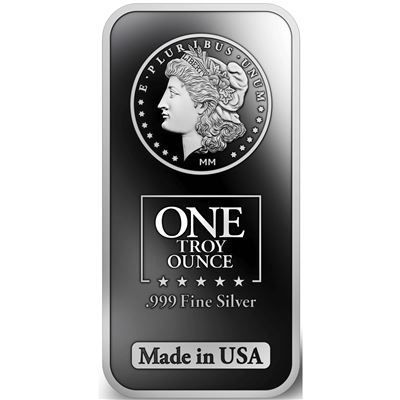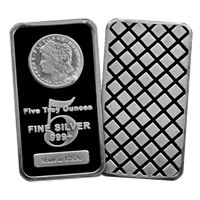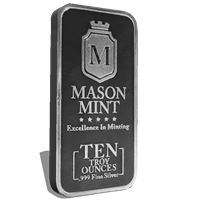1 oz Mason Mint Silver Bar - Morgan Design




| Qty | Check / Bank Wire | Credit Card |
|---|---|---|
| 1+ | $34.39 | $35.59 |
Product Highlight:
- Made in the USA
- One Troy Ounce .999 Fine Silver
- Famous Morgan Head Design On Top Of Bar
- "Generic" Silver Has Lower Premiums Than Coins


Buy 1 oz Mason Mint Silver Bar - Morgan Design
Gainesville Coins takes the worry out of investing in generic silver with the 1 oz Morgan Design silver bar. Refined to at least a 99.9% pure fineness, every one of these bars are made in the USA. When you buy these popular silver bars, you can rest assured that there is no risk of you receiving some cheap overseas knock-off with suspect purity. In fact, the 1 oz Morgan Design silver bar is one of our best-selling products. Many investors buy them in bulk.
The front of the bar features a large number “ONE” dominating the center. The inscriptions One Troy Ounce, Fine Silver, and .999+, signify that these bars have at least a “three nines” purity. Below this is the inscription Made in USA, inside a frosted rectangle.
Above all this is a detailed representation of the obverse of the Morgan dollar. The Morgan dollar design, whether on the actual 1878-1921 coins, modern 1 troy oz silver rounds, or on silver bars such as these, is one of the most popular US silver coin designs. In addition to this Morgan Design 1 oz silver bar, we offer this same design in 5 troy ounce and 10 troy ounce versions. Our 1 oz Morgan round features a reproduction of both sides of the Morgan Dollar, replacing the denomination with an inscription of the weight and purity.
When you buy a Morgan Design silver bar from Gainesville Coins, you are supporting American businesses and American jobs. For larger investors, these bars are available sealed in 500-count boxes. We are also happy to fill smaller orders, down to a single bar. There are no minimum order limits at Gainesville Coins.
History of the Morgan Dollar
The Morgan dollar is one of the most popular pre-1965 silver coins today, attracting interest from both collectors and silver stackers. However, it was not always so. In fact, the Morgan silver dollar was vilified when it introduced. It was seen as unnecessary, unwanted, and blatant pork barrel spending by Congress to the benefit of western mining interests. And frankly, it was.
The 1870s found the United States locked in a deflationary spiral that was caused on purpose by the Federal government. Dominated by banking interests and “captains of industry” in the Northeast, the government policy was to shrink the money supply until paper money no longer traded at a discount to gold. That way, gold coins would stay in circulation, and the US would be back on the Gold Standard.
The deflationary economy hit farmers and small business owners especially hard. As the value of “greenbacks” rose compared to gold, their loan payments also rose in real terms. These conditions led to the rise of “easy money” political movements, which agitated for inflationary economic policies out of Washington.
At the same time, the international price for silver was dropping, inflicting a double punch to Western silver mining companies. Making common cause with the “inflationists”, the silver miners joined the push to re-monetize silver, and reinstating the ability of citizens to present silver bullion to the US Mint in exchange for silver coins.
The Bland Allison Act
The result of this combined political leverage was the “Silver Purchase and Coinage Act of 1878”, otherwise known as the Bland-Allison Act. This act compelled the Treasury Department each and every month to buy between $2 million and $4 million in silver from US silver mining companies, and mint it exclusively into silver dollars.
The last silver dollar had been struck in 1873, from a design that originated in 1840. Dr. Henry Linderman, Director of the US Mint, took this opportunity to introduce a new silver dollar design, crafted by Assistant Engraver of the Mint George T Morgan. After some adjustments to the depth of the relief on the master hubs, the first business strike Morgan Dollar came off the press at 3:17pm on March 11, 1878. This was a mere seven working days from the passage of the Bland-Allison Act.
The Treasury Department, forced to mint a coin by the millions that no one wanted, only purchased the minimum amount of silver each month. Even so, the load on the US Mint system was so great that the New Orleans Mint, which had been closed since 1861, was refurbished and put into service in 1879.
The Sherman Silver Purchase Act
The Bland-Allison Act was not enough to stop the plunge in silver prices, as most nations in Europe dumped their silver on the open market when they converted to the Gold Standard. Easy money advocates had been disappointed that there hadn’t been more silver certificates issued to spark inflation, and once again made common cause with the silver barons.
The result was the Sherman Silver Purchase Act. Instead of a fixed dollar amount, the Treasury was ordered to purchase 4.5 million ounce of silver per month. This was enough to mint 5.8 million Morgan dollars a month, or nearly 70 million a year.
The law required the Treasury to use new “bond notes of 1890” to pay for these silver purchases, with the idea that the resulting silver dollars would be used to redeem the notes. But, the law had a fatal flaw. It specified that the notes could be redeemed “in coin” -- it did not specify silver coins! This led to everyone asking for gold coins, since the melt value of silver dollars were half that of gold.
At the same time, a massive sovereign default by Argentina almost led to the collapse of the British banking system. To replace their exhausted gold reserves, these banks converted their large US holdings to gold coins and repatriated them.
By 1893, the US was in the grips of the largest panic in its history. Banks by the hundreds, and businesses by the thousands failed. President Grover Cleveland called an emergency session of Congress to repeal the Sherman Silver Purchase Act to restore faith in the dollar. The silver barons had lost.
In 1898, silver interests managed to squeeze one last favor out of Congress.Section 34 of the War Revenue Act passed to fund the Spanish American War, directed the Secretary of the Treasury to coin into standard dollars the silver bullion on-hand since the repeal of the Sherman Silver Purchase Act. This prevented the Treasury from dumping the leftover silver on the open market.
As it worked out, this stockpiled bullion supplied Morgan dollar production for six years, through 1904.
The Pittman Act
From 1878 to 1904, 570 million Morgan dollars had been minted. The vast majority were clogging up Treasury vaults and bank vaults across the country. Instead of circulating, these silver dollars were used to back paper silver certificates.
World War One saw America’s ally Britain face a revolt in its main colony, India. Rumors were spreading that there was no silver backing the rupee silver certificates the British were using to purchase war goods. To prevent a rebellion in India that would have brought Britain to its knees, the US Congress authorized the Treasury to melt down up to 350 million silver dollars and sell the bullion to Britain. In the end, a total of 270,232,722 silver dollars were melted.This was 47.3% of all Morgan dollars minted (not counting the 1921 mintage).
To tamp down the panic of the Congressmen from the silver mining states, a clause was added to the Pittman Act that ordered the Treasury Department to mint NEW silver dollars (which would never circulate) to replace every single one that was melted. This began in 1921, after the wartime spike in silver demand had eased.
1921: The Last Morgans
The Pittman Act forced the US government to retire $1 in silver certificates for every silver dollar melted melted in 1918. To cover the currency shortage, the government issued short-term “certificates of indebtedness” paying 2% that banks could hold as part of their mandated reserves.
Retiring these certificates would save the government $5 million a month in interest debt, lending urgency to replacing the 270 million melted silver dollars so new silver certificates could be printed to redeem these interest-bearing notes.
The law declared that mass production of silver dollars for this purpose would begin as soon as practicable. The Treasury began stockpiling silver in 1920. From May 1920 to June 1921, the US Treasury purchased 66,967,630 fine ounces of silver. This was more silver purchased than any year in history (to that point). By the beginning of 1921, all was ready to begin all-out production of silver dollars. The only hurdle now was pressing new dies to actually mint them.
There were various movements, starting in 1919, for the creation of a “peace coin” to celebrate the end of the War To End All Wars. However, nothing concrete had come of these efforts, and the Mint had run out of time waiting. The new 1921 silver dollars would be a revival of the Morgan dollar.
The US Mint, never expecting in their wildest dreams that they would be striking silver dollars again, had destroyed all the Morgan dollar dies and hubs in 1910, to prevent misuse. This meant poor 76-year old George Morgan had to re-engrave the dies from scratch.
Since these silver dollars would never be released to the public, the emphasis when engraving the new master hubs was on making the dies last as long as possible. This is why the 1921 Morgans have flatter and less-detailed features than previous mintages.
From February 1921 to December, a total of 86,730,000 Morgan dollars were minted: 44,690,000 at Philadelphia, 21,695,000 at San Francisco, and 20,345,000 at Denver. This would be the first and only time the Denver Mint struck Morgan dollars. The first Peace dollars would be struck at Philadelphia in late 1921, with dies sent out to Denver and San Francisco in early 1922.
Morgan Dollar Mintages
Total mintage for the Morgan Dollar from 1878 to 1921 was just under 657 million coins. Of this number, more than 270 million were melted down under the 1918 Pittman Act -- 47.3% of all Morgan dollars minted up to that time. These melted dollars were subsequently replaced according to law, but the melted ones still count in the mintage numbers.
From the 656,979,299 Morgan dollars struck during its 27 years of production, nearly half those came from the main US Mint in Philadelphia (305,446,356). Second place, surprisingly, goes to the New Orleans Mint, which resumed operations in 1879 explicitly to help the US Mint meet mandated Morgan dollar production goals. The Mint in the Crescent City struck a total of 186,137,529 Morgan dollars.
Third place naturally goes to San Francisco. The Western US held out in their preference of silver dollars over paper banknotes until well into the 20th century. 131,188,373 Morgans were struck bearing the S mintmark. The Carson City Mint was the target of political infighting during the late 19th century, forcing it to close from mid-1885 to late 1889. Its coin presses were silenced for the final time in 1893. The tiny Mint in Nevada managed to strike 13,862,041 Morgan dollars over its 13 years of operation.
The Denver Mint began striking coins in 1906, two years after the Morgan dollar ceased production for what was thought the last time. The first and only Morgan dollar mintage from the Mint in the Mile-High City occurred in 1921, when 20,345,000 of the classic silver cartwheels rolled off the presses.
The 1960s
The last great silver dollar meltdowns occurred in the 1960s and 70s, but it wasn’t the government running the furnaces. Silver prices had been climbing in the early 1960s, as a global silver shortage showed no signs of easing. The attention this worldwide shortage received in the press led to people gathering all the silver they could, speculating that prices would continue to rise.
Starting in 1959, the hoarding of silver dimes, quarters and half-dollars by American citizens led to a severe shortage of subsidiary coins. This occurred even though the face value of the coins still exceeded their silver value. The more coins the US Mint produced, the more they were hoarded. The Mint itself was running up against higher silver prices that seemed to only increase over time. The writing was on the wall for silver coinage in the United States.
On December 2, 1964, the Director of the US Mint released a report urging the removal of silver content from circulating coins to address the shortages caused by hoarding. At the rate of consumption seen from 1960 to 1964, it was estimated that the Treasury Department would be completely out of silver by 1967. It was noted that debasing the fractional silver coins by half, to raise the “melting point” to $2.76 an ounce, would only delay the inevitable. Silver prices would simply rise to that point, the global shortages were so acute.
The Coinage Act of July 23, 1965 replaced all silver dimes and quarters with nickel-clad coins with a copper core. The half dollar was changed to have a copper core containing 20.9% silver, sandwiched between two layers of 80% pure silver cladding for a total purity. The first clad coins, 230 million quarters, were released the first week of November.
By this time, silver prices were already touching the point where it make sense to melt silver dollars, rather than spend them. By 1967, prices were well above the $1.38/oz level for good, making melting all that silver change profitable, as well as the dollars. Sealed bags of $1000 face value silver coins were literally piled into trucks and moved from Treasury vaults, to wholesalers, to the refiners, with no one looking to see whether any rare coins had been included.
Collecting Morgan Dollars
Collecting Morgan dollars had become the first “mainstream” coin fad since the Flying Eagle one cent piece replaced “large cents” in 1857. Just as these new collectors were entering the market, the market itself had been thrown into chaos by the great silver dollar meltings, and the release from Treasury vaults of giant bags of silver dollars that had not seen the light of day for decades. Rare Morgan dollars were suddenly commonplace, and common dates had seen so many melted that the survivors had become scarce.
The market was shaken up even more in the 1970s. The discovery of large Morgan dollar hoards such as the Redfield Hoard, the Continental-Illinois Bank Hoard, and the GSA sale of millions of uncirculated Carson City Morgan dollars found in Treasury vaults kept excitement high among a burgeoning number of Morgan dollar collectors.
The last big silver dollar meltdown was spurred by the attempt by the Hunt Brothers to corner the world silver market in 1980. This saw a silver shortage worse than anything seen in a hundred years. Silver prices went from $4.38 on January 18, 1977, to spike in one terrible day to over $50/oz during trading on January 18, 1980. This is a price that has never been exceeded, even during the bull market that ended in 2011.
Our Morgan Design 1oz silver bar is made in the USA, just like the original Morgan dollars. Even better, each bar is made from 1 troy ounce of 99.9% pure silver, rather than the 90% silver of the original coin. This is one of the best-selling items we offer at Gainesville Coins. Buy some today and see why!

Specification
Related Products
Customer Ratings & Review
Review This Product
Share your thoughts with other customers.






